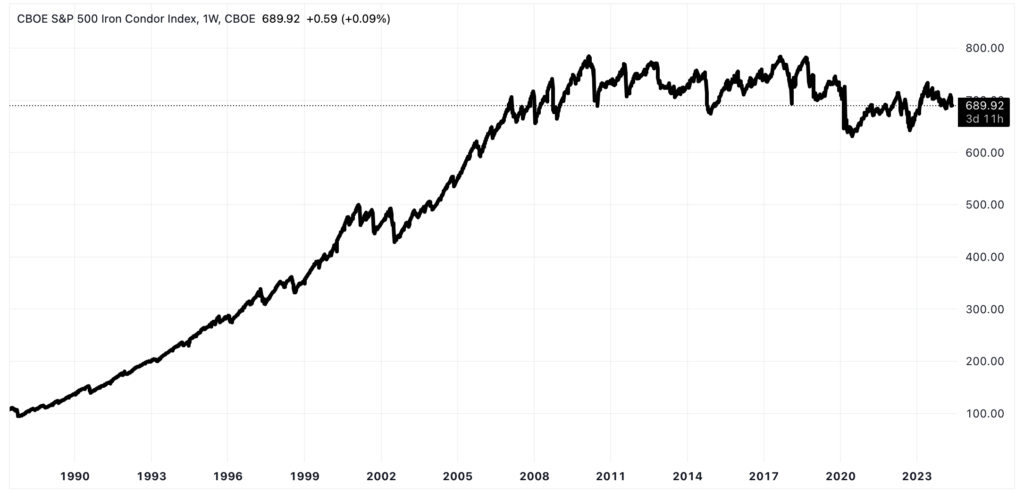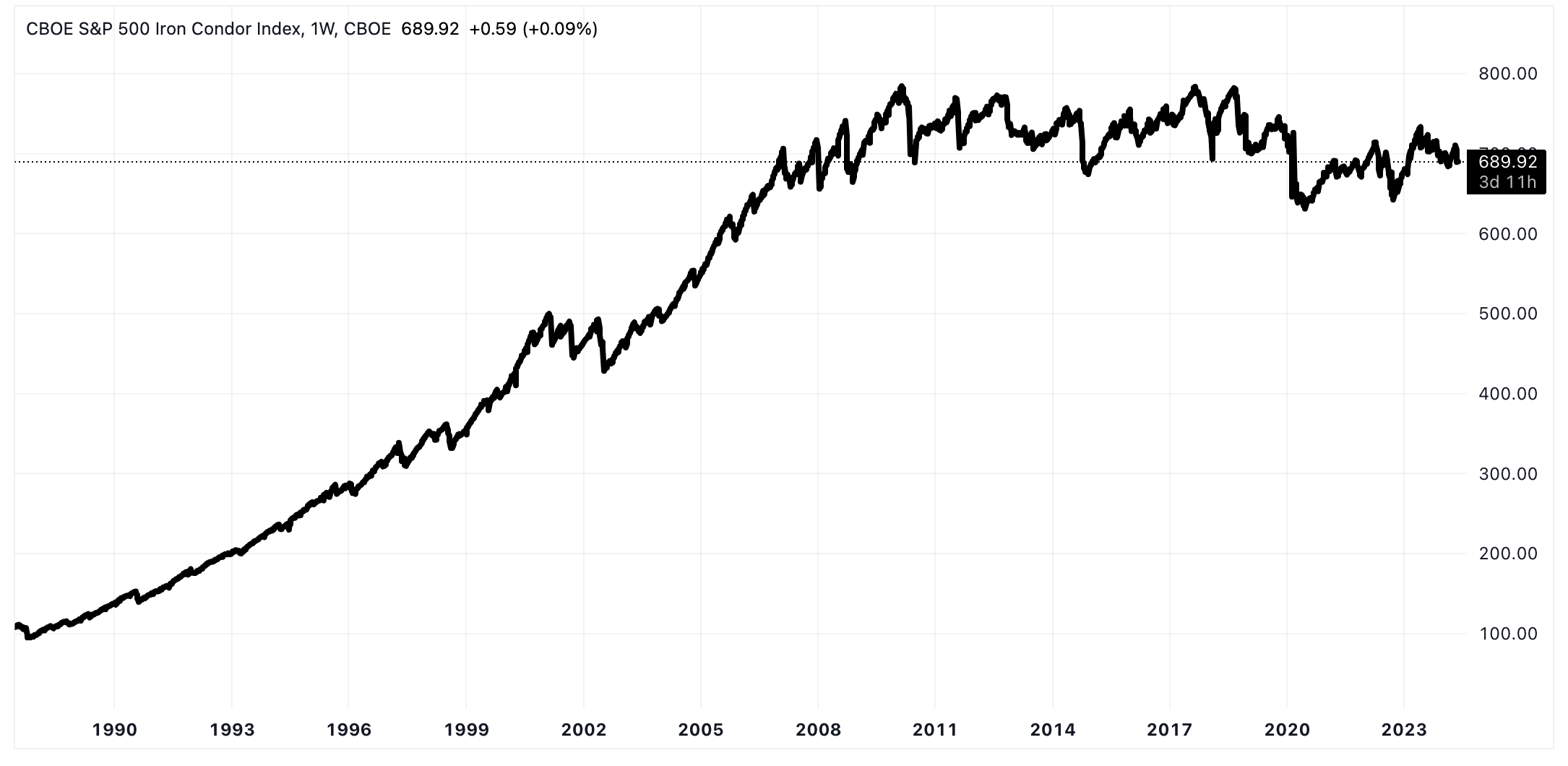Most people’s portfolios don’t have anything that can profit unless the market is going up. Traditional investments, like stocks, need upward movement to generate returns, leaving you with limited opportunities when the market is flat. The Iron Condor options trading strategy offers a compelling alternative by profiting from a lack of significant price movement in the underlying asset. Unlike traditional investments, the Iron Condor allows you to generate consistent income even in a range-bound market. This makes it also a valuable tool for investors looking to diversify their portfolio and benefit from periods of decreasing implied volatility.
However, a different picture emerges when you look at backtests or the CBOE S&P 500 Iron Condor Index (CNDR), a benchmark index that tracks the hypothetical performance of a monthly SPX Iron Condor with short options at ~20 deltas and long options at ~5 deltas, with no trade adjustments. While the strategy once boasted impressive returns, recent years have cast a shadow over its efficacy. The dream of easy money with Iron Condors can get deflated by reality. The CNDR’s actual performance, especially in recent years, hasn’t lived up to the hype.

Is the Iron Condor strategy dead?
From January 1987 to January 2010, the CNDR index soared, showcasing a compound annual growth rate of +9.11%. However, the narrative shifts dramatically when we look at the last fourteen years. Instead of growth, we see stagnation, with the index barely moving from 770.28 to 690.78, resulting in a -0.72% compound annual return. This downturn has significantly dampened the strategy’s overall performance, bringing it down to 5.28% over the entire 37-year period. The question begs: has the Iron Condor strategy lost its edge?
The recent lackluster performance suggests that the market environment, marked by enduringly low volatility, hasn’t been conducive to its success, especially concerning the S&P 500 Index. Yet, before we dismiss the strategy entirely, it’s crucial to remember that all strategies experience fluctuations. Rather than declaring it “dead,” it’s wiser to acknowledge these periods of underperformance as part of the trading journey. By diversifying strategies and remaining adaptable, traders can navigate through these challenging phases, knowing that cycles of better market conditions might be just around the corner.
Iron Condors and Implied Volatility
Iron Condors are best suited for high volatility environments. In these conditions, they can capture higher premiums because options prices are higher, making them more profitable. However, in low volatility (IV) environments, Iron Condors are harder to execute profitably because lower volatility means lower premiums from selling options. Additionally, the profit zones are narrower in low IV environments, increasing the chances of breaches and potential losses since the underlying asset has less room to move. Furthermore, the current low volatility environment combined with a strong bull market makes Iron Condors an unattractive strategy. They are often breached on the call side, reducing the potential for profit and increasing the risk of significant losses. So, are there any best practices we can follow to increase our success rate?
My Entry and Management Rules
Rule 1: Trade Highly Liquid Assets Only. When trading Iron Condors, always stick to highly liquid assets. Index or ETFs, are preferred over individual stocks because they reduce volatility and offer better stability. Additionally, high liquidity ensures you won’t lose money on entry and exit trades due to wide spreads and inefficiencies, which can add up over time.
Rule 2: Match Strategy with Volatility. Iron Condors thrive in mid to high volatility environments because they are short volatility trades. This means you profit as volatility decreases. Understanding when to use each strategy based on volatility is crucial for maximizing returns.
Rule 3: Avoid Strong Trends. You’d use iron condor in a neutral bias stock market, where you think the implied volatility of the market is higher than the realized volatility you may see. When selling an iron condor, you are betting against the underlying moving past your short put or short call spread. Therefore, avoid opening new trades during strong market trends, whether the trend is up or down. Instead, wait for a pullback or a slight reversal towards the medium-term average.
Rule 4: Optimal Expiration Dates. Target 45-75 DTE for your Iron Condor trades. Shorter expiration periods can be riskier due to higher gamma risk. Higher gamma means that the price of the options can change rapidly, making the trade more sensitive to underlying price movements. Longer periods offer wider wings and slower movements, providing a larger margin for error. Ideally, aim for 60 days, but anything within 45 to 75 days works well.
Rule 5: Strike Selection. For the short strike of your Iron Condor, target a Delta of 16 or less on both sides. This means selecting strikes where the delta is around 16, indicating a lower probability of the option expiring in-the-money. We shoot for collecting 1/3rd the width of the strikes in premium upon trade entry. For example, if we have an Iron Condor with three point wide spreads, we will look to collect $1.00 for the trade. This gives us a probability of success around 67%, which balances risk and reward effectively.
Rule 6: Manage early. You should take profit on an Iron Condor when you reach a profit target that you are shooting for. Much like other standard premium selling strategies, I close Iron Condors when I reach 25-50% of my max profit. Closing winners early will increase your win rate over time, as you are taking risk off the table and locking in profits. When needed, manage Iron Condors by adjusting the untested side. I look to roll the untested spread closer to the stock price to collect more premium.
By following these rules, you can master the Iron Condor strategy and enhance your trading skills. Remember, practice and patience are key. Use the guidelines above to inform your trades, and over time, you’ll see the benefits of a well-executed Iron Condor strategy. Trading market-neutral Iron Condors can be very profitable and add much-needed diversification to any investor’s portfolio.

One response to “Never Trade Iron Condors Blindly: Here’s How to Actually Profit with This Strategy”
A key rule for iron condors is to position the wings far out.